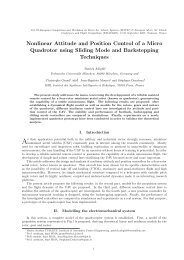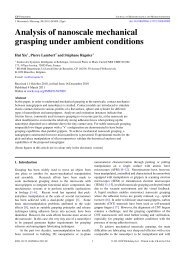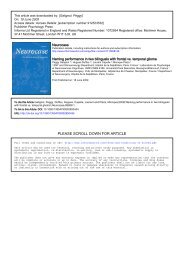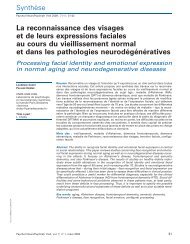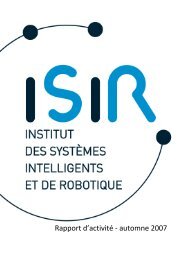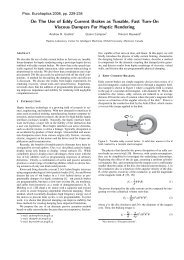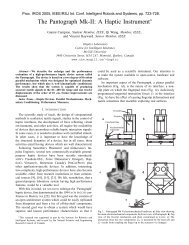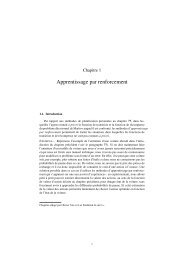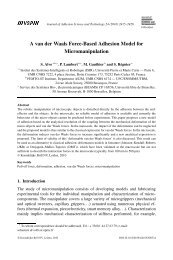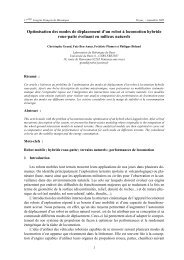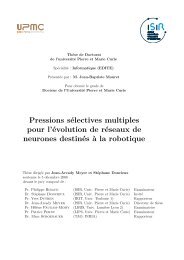Trajectory Control of a Four-Wheel Skid-Steering Vehicle Over Soft ...
Trajectory Control of a Four-Wheel Skid-Steering Vehicle Over Soft ...
Trajectory Control of a Four-Wheel Skid-Steering Vehicle Over Soft ...
You also want an ePaper? Increase the reach of your titles
YUMPU automatically turns print PDFs into web optimized ePapers that Google loves.
2007 IEEE International Conference on<br />
Robotics and Automation<br />
Roma, Italy, 10-14 April 2007<br />
WeD5.2<br />
<strong>Trajectory</strong> <strong>Control</strong> <strong>of</strong> a <strong>Four</strong>-<strong>Wheel</strong> <strong>Skid</strong>-<strong>Steering</strong> <strong>Vehicle</strong> over S<strong>of</strong>t<br />
Terrain using a Physical Interaction Model<br />
D. Lhomme-Desages ∗ ,Ch.Grand ∗ and J-C. Guinot ∗<br />
∗ Laboratoire de Robotique de Paris<br />
Route du Panorama, 92260 Fontenay-aux-Roses<br />
lhomme@robot.jussieu.fr, grand@robot.jussieu.fr, guinot@robot.jussieu.fr<br />
Abstract— A model-based control for fast autonomous fourwheel<br />
mobile robots on s<strong>of</strong>t soils is developed. This control<br />
strategy takes into account slip and skid effects to extend the<br />
mobility over planar granular soils. Each wheel is independently<br />
actuated by an electric motor. The overall objective is to follow<br />
a path roughly at relatively high speed. Some results obtained<br />
in dynamic simulation are presented.<br />
I. INTRODUCTION<br />
Many popular controllers for wheeled mobile robots assume<br />
that wheels roll without slipping. This leads to a<br />
nonholonomic constraint added to the kinematic or dynamic<br />
model [1]. This assumption is quite legitimate for usual<br />
applications such as autonomous cars over hard terrains or<br />
slow indoor exploration. However, it is no longer suitable for<br />
many applications where wheel slip cannot be neglected [2],<br />
especially for traveling over natural soils at high speed [3].<br />
With this type <strong>of</strong> control architecture, the stability <strong>of</strong> the<br />
rover cannot be guaranteed in presence <strong>of</strong> slippage, due to<br />
the dynamics <strong>of</strong> the vehicle and the saturation <strong>of</strong> admissible<br />
forces by the soil. Therefore, a new control scheme is<br />
required.<br />
In this paper, a model-based control method for fast<br />
autonomous mobile robots on s<strong>of</strong>t soils is developed. On<br />
such a type <strong>of</strong> terrain (sand for instance), slip and skid<br />
phenomena may be significant. The control strategy takes<br />
into account these effects to extend the mobility <strong>of</strong> the<br />
vehicles over natural soils. The terrains considered here are<br />
horizontal and relatively smooth compared to the size <strong>of</strong> the<br />
wheels.<br />
A non-linear model-based control <strong>of</strong> wheel slippage is<br />
studied, using a semi-empirical wheel-soil interaction model.<br />
A higher-level control is applied to a four-wheel skid-steering<br />
vehicle which can travel at relatively high speed (several<br />
meters per second). Each wheel is independently actuated<br />
by an electric motor.<br />
The overall objective is to follow a given trajectory at<br />
relatively high speed. This controller implies a low-level<br />
control method that aims to regulate the slip rate <strong>of</strong> one<br />
wheel, since the traction force generated by the rotation <strong>of</strong><br />
the wheel at the contact patch depends on the wheel slip.<br />
Limitations and required sensors are also pointed out.<br />
Finally, this control scheme is evaluated in dynamic simulation.<br />
The results show an improvement <strong>of</strong> motion control<br />
when implementing the model-based traction control.<br />
II. SYSTEM MODELLING<br />
A. Rover model<br />
We consider a skid-steering vehicle with four independent<br />
electrically driven wheels. The kinematic and geometric<br />
parameters <strong>of</strong> the vehicle are shown on figure 1.<br />
X<br />
M ψ<br />
O3<br />
Y<br />
ψ<br />
F Y<br />
b F X<br />
a<br />
O4<br />
G<br />
O2<br />
v<br />
Γ<br />
y<br />
F l1 F<br />
ω<br />
t1<br />
R<br />
O1<br />
F t<br />
x<br />
z X<br />
O<br />
Fig. 1.<br />
Model <strong>of</strong> a four-wheel rover<br />
The center <strong>of</strong> mass G is located at the center <strong>of</strong> the<br />
platform. See Tab. I for a description <strong>of</strong> notations. ψ is the<br />
orientation <strong>of</strong> the vehicle relatively to (O, x).<br />
B. <strong>Wheel</strong>-soil interaction model<br />
Several modeling frameworks can be used to calculate the<br />
forces involved in the wheel-soil interaction process. We use<br />
an extended version <strong>of</strong> the terramechanic model introduced<br />
by Bekker ([4],[5]). We assume that the entire wheel is very<br />
stiff compared to the ground and we can consider that the<br />
wheel is rigid (Fig. 2).<br />
D<br />
R<br />
F n<br />
ω<br />
R<br />
θ θ 1<br />
z<br />
R r<br />
z<br />
F t<br />
w w l<br />
Fig. 2.<br />
Model <strong>of</strong> a rigid wheel<br />
v<br />
1-4244-0602-1/07/$20.00 ©2007 IEEE. 1164
WeD5.2<br />
Denote v the velocity <strong>of</strong> the center <strong>of</strong> the wheel, and ω<br />
the angular velocity <strong>of</strong> the wheel. In this model, the traction<br />
force depends on the slip rate s, which is defined as:<br />
{ 1 −<br />
v<br />
s =<br />
ω.R<br />
if Rω ≥ v<br />
1 − ω.R<br />
(1)<br />
v<br />
if Rω < v<br />
for v>0 and ω>0. This definition can be extended to<br />
every (v, ω) ∈R 2 , as is shown in Fig. 3.<br />
F tmax<br />
F t (N)<br />
−F tmax<br />
19<br />
16<br />
13<br />
10<br />
7<br />
4<br />
1<br />
0<br />
s<br />
z =5mm<br />
F n =44.2 N<br />
8 6 4 2 0 0.2 0.4 0.6 0.8 1<br />
Fig. 4.<br />
Traction force vs. slip rate<br />
Fig. 3.<br />
Slip rate as a function <strong>of</strong> v and Rω<br />
F l = μ l (d l ).F n = μ ls<br />
(<br />
1 − e d l/d ls<br />
)<br />
F n (6)<br />
where d ls and μ ls are soil characteristics, d l is the lateral<br />
displacement.<br />
This contact model has been validated by experimental<br />
measurements on an instrumented testing bench (Fig. 5).<br />
A set <strong>of</strong> experimental data is depicted in Fig. 6. A curvefitting<br />
algorithm is used to find the soil parameters <strong>of</strong> the<br />
interaction model. The resulting curve fits relatively well the<br />
data, despite a high experimental noise <strong>of</strong> about ±10 N.<br />
According to Bekker theory [4], the normal force depends<br />
on the wheel sinkage z through:<br />
F n = 1 [ ( )<br />
kc<br />
w w<br />
3 r + k φ (3 − n) √ ]<br />
Dz 2n+1<br />
2 (2)<br />
where k c , k φ and n are soil parameters. w w is the width <strong>of</strong><br />
the wheel.<br />
r = min(w w ,l), l being the length <strong>of</strong> the contact patch.<br />
The net traction force DP (also known as drawbar pull) is<br />
the difference between the raw traction force and the rolling<br />
resistance:<br />
Fig. 5.<br />
Experimental device<br />
DP(s) =F t (s) − R r (3)<br />
In this study, the rolling resistance is assumed to be<br />
mainly caused by soil compaction, which allows to use the<br />
expression:<br />
z n+1 ( )<br />
kc<br />
R r = w w<br />
n +1 r + k φ<br />
(4)<br />
The raw traction force is related to the slip rate:<br />
[ (<br />
F t (s) =F )]<br />
m 1 −<br />
K<br />
s.l 1 − e<br />
−s.l/K<br />
(5)<br />
F m = lw w c + F n tan φ<br />
where c, φ and K are soil cohesion, friction angle and shear<br />
deformation modulus, respectively.<br />
The shape <strong>of</strong> F t is plotted on Fig. 4 with parameters <strong>of</strong><br />
Tab. I. This is a monotonic function and it reaches its extreme<br />
values ±F tmax for extreme values <strong>of</strong> s.<br />
Lateral forces can be implemented, including bulldozing<br />
resistance, as described in [6]. In this study, we use a simple<br />
linearized Coulomb model for lateral forces:<br />
III. TRAJECTORY TRACKING CONTROL<br />
The objective <strong>of</strong> this model-based control scheme is the<br />
tracking <strong>of</strong> a reference trajectory given under the form<br />
(x ∗ (t),y ∗ (t),ψ ∗ (t)).<br />
We denote F the global vector <strong>of</strong> forces and torque applied<br />
to the center <strong>of</strong> mass <strong>of</strong> the platform, in the local frame<br />
attached to the chassis. This vector has two components<br />
since the lateral motion is uncontrollable: no combination<br />
<strong>of</strong> traction forces can result in a lateral motion. Therefore,<br />
the lateral component F Y is ignored:<br />
[ ]<br />
FX<br />
F =<br />
(7)<br />
M ψ<br />
A. <strong>Control</strong> architecture<br />
Figure 7 presents the overall control system. The role <strong>of</strong><br />
the trajectory controller is to generate a proper desired global<br />
force F ∗ . Then each raw traction force F ∗<br />
t is computed<br />
from the global desired force by solving the forces balance.<br />
Lateral forces and rolling resistance are estimated using the<br />
1165
WeD5.2<br />
( x ∗ , y ∗ , ψ ∗ )<br />
y<br />
x<br />
M ψ<br />
∗<br />
v ∗<br />
d<br />
ψ ∗˜ψ<br />
G<br />
F X<br />
∗<br />
ψ<br />
Fig. 8.<br />
Parameters for the trajectory control<br />
Fig. 6.<br />
Experimental measure <strong>of</strong> drawbar pull<br />
terramechanic model. The inversion <strong>of</strong> the estimated wheelsoil<br />
contact model provides the desired slip rate s ∗ from F t ∗ .<br />
X ∗<br />
Ẋ ∗<br />
Dynamic<br />
<strong>Trajectory</strong><br />
<strong>Control</strong>ler<br />
F ∗ +<br />
∗<br />
A t<br />
F t<br />
F<br />
ˆF l<br />
lateral forces<br />
estimator<br />
Fig. 7.<br />
s<br />
s ∗<br />
X<br />
Traction<br />
<strong>Control</strong>ler<br />
slip<br />
computer<br />
Ẋ<br />
s<br />
<strong>Control</strong> block diagram<br />
This architecture is composed <strong>of</strong> two stages, the trajectory<br />
control and the traction control, which are detailed in the<br />
next sections. The traction controller regulates the slip rate<br />
<strong>of</strong> each wheel.<br />
The input desired torques are saturated to ensure that<br />
desired values do not exceed actuators capabilites.<br />
B. <strong>Trajectory</strong> controller<br />
The trajectory controller is a high-level module that<br />
generates a desired F ∗ corresponding to a desired motion<br />
<strong>of</strong> the robot toward the desired trajectory (Fig. 8). The<br />
desired global force depends on the kinematic and geometric<br />
situation (F ∗ = f(X, Ẋ)).<br />
Note d the distance between the platform center <strong>of</strong> mass<br />
and the desired reference position.<br />
Define the errors in velocity and heading angle:<br />
Γ<br />
Rover<br />
e v = v ∗ − v (8)<br />
e ψ = ˜ψ − ψ (9)<br />
Instead <strong>of</strong> the reference angle ψ ∗ (t) <strong>of</strong> the reference<br />
trajectory, the desired angle is:<br />
ω<br />
˜ψ(d) =ψ ∗ − arctan(k f d) (10)<br />
This defines a modified reference angle that depends also<br />
on the distance d. k f is a tuning parameter. Equation (10)<br />
is intended to reduce the distance to the reference trajectory<br />
even with a passive lateral motion.<br />
A simple strategy may be defined as the following:<br />
F X ∗ = k pX e v + k iX<br />
∫<br />
e v (11)<br />
M ψ ∗ = k pψ e ψ + k iψ<br />
∫<br />
e ψ + k dψ e˙<br />
ψ (12)<br />
where k iX , k pX , k pψ , k iψ and k dψ are gains. This defines a<br />
PI-controller on operational velocity v and a PID-control <strong>of</strong><br />
the heading angle ψ.<br />
C. Tractive force distribution<br />
Each wheel is subjected to tangential lateral and longitudinal<br />
contact forces, gathered in corresponding vectors:<br />
F t =[DP 1 ,DP 2 ,DP 3 ,DP 4 ] T (13)<br />
F l =[F l1 ,F l2 ,F l3 ,F l4 ] T (14)<br />
The position <strong>of</strong> the robot is the position <strong>of</strong> the platform<br />
center <strong>of</strong> mass in the referential frame:<br />
X =[x, y, ψ] T (15)<br />
and ω is the vector <strong>of</strong> angular velocities <strong>of</strong> the wheels.<br />
For each wheel, we can separate the contributions <strong>of</strong> lateral<br />
and longitudinal forces, which are related to the global force<br />
by a linear equation:<br />
) )<br />
F = A t F t<br />
(Ẋ, ω + A l F l<br />
(Ẋ (16)<br />
with:<br />
A t =<br />
[<br />
1 1 1 1<br />
b b −b −b<br />
]<br />
(17)<br />
1166
WeD5.2<br />
A l =<br />
[<br />
0 0 0 0<br />
−a a a −a<br />
]<br />
(18)<br />
Therefore, assuming translation and angular velocities are<br />
known, we can deduce the longitudinal forces to apply. Angular<br />
velocities can be easily measured via optical encoders.<br />
Ground velocity can be estimated using a Doppler sensor for<br />
instance [7].<br />
We can inverse the linear system (16) by minimizing the 2-<br />
norm <strong>of</strong> vector Ft (thus minimizing tractive efforts). Using<br />
the pseudo-inverse <strong>of</strong> A t , the optimal tractive efforts are<br />
computed from equation (19), where hats denote estimated<br />
values, and stars denote desired values:<br />
( )<br />
F ∗ +<br />
t = A t F ∗ − A l̂Fl (19)<br />
The pseudo-inverse <strong>of</strong> this matrix A t can be symbolically<br />
solved:<br />
⎡ ⎤<br />
b 1<br />
A + t = 1 ⎢ b 1 ⎥<br />
⎣<br />
4b b −1 ⎦ (20)<br />
b −1<br />
D. Model-based traction control<br />
In order to apply motor torques corresponding to desired<br />
traction efforts, the interaction contact model is used to take<br />
into account the capabilities <strong>of</strong> the ground.<br />
The forces balance equation gives the desired net traction<br />
force DP for each wheel. Using the Bekker-Wong model<br />
described in section II, the rolling resistance is first estimated<br />
from eq. (4). To perform this estimation, an estimation <strong>of</strong> the<br />
sinkage z is calculated on the basis <strong>of</strong> eq. (2). Normal forces<br />
F ni are assumed to be equal to the fourth <strong>of</strong> the total weight:<br />
F ni =(m c +4m r )g/4, 1 ≤ i ≤ 4 (21)<br />
This strong assumption means that the center <strong>of</strong> mass is<br />
located at the center <strong>of</strong> the platform and that there is no<br />
lateral or longitudinal load transfers.<br />
Then, the raw traction force F t is computed using eq. (3).<br />
Finally, the F t (s) function (eq. (5)) can be inversed to obtain<br />
a desired slip rate.<br />
The tractive efforts can be unreachable if we consider the<br />
contact model. If the desired force is not admissible by the<br />
soil (|F t | > F tmax , i.e. |s| = 1), then the robot will be<br />
unable to follow the path with accuracy and will skid.<br />
The lateral efforts ̂F l are estimated with the lateral contact<br />
model and a measure <strong>of</strong> the kinematic state <strong>of</strong> the vehicle.<br />
E. Slip servoing<br />
Several slip control methods exist in the literature, including<br />
nonlinear and gain-scheduled PID, sliding mode [8],<br />
fuzzy logic [9], or Lyapunov synthesis [10].<br />
Simple slip control strategies have been used for several<br />
mobile robots in rough terrain ([11], [12]). Like these<br />
authors, we implement a simple PI-controller (Fig. 9). A<br />
derivative gain is inappropriate since the slip rate is a<br />
s ∗<br />
+<br />
-<br />
Fig. 9.<br />
s<br />
1<br />
s<br />
K i<br />
K p<br />
slip<br />
+<br />
+<br />
Γ<br />
Motor<br />
<strong>Control</strong> block diagram with PI-controller<br />
discontinuous function. Each independent electric motor is<br />
controlled in torque (namely in current).<br />
Numerical simulations <strong>of</strong> a one-wheel vehicle have been<br />
led in a dynamical multibody modeling s<strong>of</strong>tware [13]. An<br />
extension to this s<strong>of</strong>tware has been developed to implement<br />
the terramechanic contact model. The step response <strong>of</strong> the<br />
controller is depicted on Fig. 10 (s ∗ =0.8, K p = K i = 100).<br />
1.0<br />
0.8<br />
0.75<br />
0.5<br />
0.25<br />
0.0<br />
0.0<br />
s<br />
s ∗<br />
0.5<br />
time (seconds)<br />
Fig. 10. Comparison between step desired and simulated slip rate with<br />
PI-control<br />
After a short period where s is not continuous (at t =0 + ,<br />
v =0and ω>0, see Fig. 3), it converges toward the desired<br />
value.<br />
IV. SIMULATION RESULTS<br />
To simulate the behavior <strong>of</strong> the robot, a simple desired<br />
maneuver has been chosen, which is a right bend at constant<br />
desired tangential velocity (1.7 m/s) after an acceleration<br />
phase at constant rate. The minimal radius <strong>of</strong> curvature is 54<br />
cm. Kinematic, dynamical and contact parameters are given<br />
in the table I. Soil parameters correspond to a dry sandy<br />
soil [5]. Dynamic and geometrical parameters are those <strong>of</strong> a<br />
project <strong>of</strong> a testing skid-steering platform.<br />
A passive revolute joint has been introduced between both<br />
sides <strong>of</strong> the platform to guarantee an isostatic contact.<br />
A. <strong>Trajectory</strong> control without traction control<br />
In order to test and validate the traction control, a simulation<br />
is made without the model-based traction control<br />
subsystem. Therefore, the contact model is not involved in<br />
the control architecture and the lateral forces are ignored,<br />
which means they are processed as perturbations. Since the<br />
contact model is not used, the rolling resistance is also<br />
ignored, so it is implicitly assumed that F t = DP for each<br />
wheel.<br />
In this case, the distribution <strong>of</strong> the global desired force is:<br />
1.0<br />
1.5<br />
2.0<br />
1167
WeD5.2<br />
TABLE I<br />
SIMULATION PARAMETERS<br />
m r 1 kg wheel mass<br />
m c 14 kg chassis mass<br />
J 1.03.10 −2 kg.m 2 wheel inertia<br />
R 10 cm wheel radius<br />
w w 6 cm wheel width<br />
a 35 cm half wheelbase<br />
b 23 cm half track width<br />
n 0.705 soil exponent<br />
k c 6940 N.m −(n+1) cohesive modulus<br />
k φ 505800 N.m −(n+2) friction modulus<br />
φ 31.5 deg friction angle<br />
c 1150 Pa cohesion<br />
K 1.15 cm soil modulus<br />
K p 300 proportional gain for slip servoing<br />
K i 1000 integral gain for slip servoing<br />
rad<br />
1.57<br />
0.3925<br />
0.0<br />
-0.785<br />
-1.9625<br />
-3.14<br />
0.0<br />
Fig. 13.<br />
1.0 2.0<br />
3.0<br />
ψ<br />
˜ψ<br />
4.0<br />
time (seconds)<br />
ψ ∗<br />
5.0 6.0 7.0<br />
Rover direction and desired heading angle<br />
1.5<br />
F t ∗ = A t + F ∗ (22)<br />
1.5<br />
v ∗<br />
For each wheel, the desired traction force Ft<br />
∗<br />
translated to a torque using:<br />
is directly<br />
m/s<br />
0.5<br />
v<br />
Γ=RF t<br />
∗<br />
(23)<br />
The inertial term <strong>of</strong> the dynamic equation <strong>of</strong> the wheel<br />
motion is ignored, as well as the soil capabilities. The<br />
resulting control architecture is represented on Fig. 11.<br />
0.0<br />
-0.5<br />
0.0<br />
1.0<br />
2.0<br />
3.0<br />
4.0<br />
time (seconds)<br />
5.0<br />
6.0<br />
7.0<br />
X<br />
Fig. 14.<br />
Rover velocity<br />
X ∗<br />
Ẋ ∗<br />
Dynamic<br />
<strong>Trajectory</strong><br />
<strong>Control</strong>ler<br />
F ∗<br />
A t<br />
+<br />
F t<br />
∗<br />
1/R<br />
Γ<br />
Ẋ<br />
Rover<br />
It can be seen from Fig. 15 that the slip rate reaches its<br />
maximum (soil failure regions). The ground cannot admit<br />
traction forces that are required to stabilize the system.<br />
Fig. 11.<br />
<strong>Control</strong> block diagram<br />
1.0<br />
The simulation gives the sequence shown in Fig. 12.<br />
10<br />
0.5<br />
0.0<br />
s 1<br />
s 3<br />
y(m)<br />
-0.5<br />
-1.0<br />
0.0<br />
1.0<br />
2.0<br />
3.0 4.0<br />
time (seconds)<br />
soil failure<br />
5.0<br />
6.0<br />
soil failure<br />
7.0<br />
Fig. 15.<br />
Slip rates<br />
1<br />
0 1<br />
x(m) 10<br />
Fig. 12. Trace <strong>of</strong> the motion <strong>of</strong> the rover<br />
The unstable behavior <strong>of</strong> the system is clearly highlighted.<br />
For this particular set <strong>of</strong> parameters and gains, the system<br />
is unstable. More generally, the control <strong>of</strong> this type <strong>of</strong><br />
autonomous robots in presence <strong>of</strong> large slip is problematic.<br />
B. Model-based <strong>Trajectory</strong> control<br />
With the implementation <strong>of</strong> the control architecture developed<br />
in this paper, we obtain the sequence <strong>of</strong> the figure 16.<br />
Despite the lack <strong>of</strong> accuracy <strong>of</strong> the tracking, which is sec-<br />
1168
WeD5.2<br />
d =1.2m<br />
max<br />
Fig. 19.<br />
<strong>Skid</strong>-steering demonstrator<br />
rad<br />
1.0<br />
0.5<br />
0.0<br />
-0.5<br />
-1.0<br />
-1.5<br />
Fig. 16.<br />
Trace <strong>of</strong> the motion <strong>of</strong> the rover<br />
-2.0<br />
-2.5<br />
-3.0<br />
-3.5<br />
0.0<br />
Fig. 17.<br />
1.0<br />
2.0<br />
3.0<br />
4.0<br />
time (seconds)<br />
ψ ∗˜ψ<br />
V. CONCLUSION AND FUTURE WORKS<br />
The controller presented in this paper may be useful to<br />
achieve better performances on challenging terrains such as<br />
planetary surfaces, but requires a larger instrumentation. In<br />
particular, this model-based control may be used for obstacle<br />
avoidance at high speed.<br />
Further works are being made to implement this control<br />
strategy in a fast mobile robotic platform under development<br />
(Fig. 19). Absolute ground velocity will be measured with<br />
a Doppler radar sensor. Robustness and sensitivity to soil<br />
parameters have to be evaluated. If the algorithm is robust<br />
enough, then a real-time nonlinear estimation <strong>of</strong> contact<br />
parameters is not required as long as the terrain is relatively<br />
homogeneous. An <strong>of</strong>f-line initialization procedure may be<br />
suitable.<br />
m/s<br />
2.0<br />
1.5<br />
1.0<br />
0.5<br />
0.0<br />
-0.5<br />
-1.0<br />
0.0<br />
1.0<br />
Rover direction and desired heading angle<br />
2.0<br />
Fig. 18.<br />
3.0<br />
4.0<br />
v<br />
v ∗<br />
time (seconds)<br />
5.0<br />
5.0<br />
Rover velocity<br />
ondary for high-speed applications, the control architecture<br />
allows the stability <strong>of</strong> the system.<br />
The figure 18 shows that the tangeantial velocity can be<br />
negative, which is acceptable, but very inefficient for power<br />
consumption.<br />
These results show that the trajectory tracking is improved<br />
under such conditions with the model-based control scheme<br />
developed in section III .<br />
ψ<br />
6.0<br />
6.0<br />
7.0<br />
7.0<br />
8.0<br />
8.0<br />
REFERENCES<br />
[1] L. Caracciolo, A. De Luca, and S. Iannitti, “<strong>Trajectory</strong> tracking control<br />
<strong>of</strong> a four-wheel differentially driven mobile robot,” in Proc. IEEE Intl<br />
Conf. on Robotics & Automation, Detroit, USA, May 1999, pp. 2632–<br />
2638.<br />
[2] T. Huntsberger, H. Aghazarian, Y. Cheng, E. Baumgartner, E. Tunstel,<br />
C. Leger, A. Trebi-Ollennu, and P. S. Schenker, “Rover autonomy<br />
for long range navigation and science data acquisition on planetary<br />
surfaces,” in Proc. IEEE Intl Conf. on Robotics & Automation,<br />
Washington DC, USA, May 2002, pp. 3161–3168.<br />
[3] M. Spenko, K. Iagnemma, and S. Dubowsky, “High speed hazard<br />
avoidance for mobile robots in rough terrain,” in SPIE Conf. on<br />
Unmanned Ground <strong>Vehicle</strong>s, 2004.<br />
[4] M. Bekker, Introduction to Terrains-<strong>Vehicle</strong>s Systems. The University<br />
<strong>of</strong> Michigan Press, 1969.<br />
[5] J. Y. Wong, Terramechanics and Off-Road <strong>Vehicle</strong>s. Elsevier, 1989.<br />
[6] G. Ishigami, A. Miwa, and K. Yoshida, “<strong>Steering</strong> trajectory analysis <strong>of</strong><br />
planetary exploration rovers based on all-wheel dynamics model,” in<br />
8th Intl Symposium on Artifical Intelligence, Robotics and Automation<br />
in Space, Munich, Germany, Sept. 2005.<br />
[7] S. Stuchly, A. Thansandote, J. Mladek, and J. Townsend, “A doppler<br />
radar velocity meter for agricultural tractors,” IEEE Trans. Veh.<br />
Technol., vol. 27, no. 1, pp. 24–30, Feb. 1978.<br />
[8] K. Buckholtz, “Reference input wheel slip tracking using sliding<br />
mode control,” in SAE World Congress Detroit, Society <strong>of</strong> Automotive<br />
Engineers. SAE, Mar. 2002.<br />
[9] F. Yu, J.-Z. Feng, and J. Li, “A fuzzy logic controller design for vehicle<br />
abs with a on-line optimized target wheel slip ratio,” Intl Journal <strong>of</strong><br />
Automotive Technology, vol. 3, no. 4, pp. 165–170, 2002.<br />
[10] J. Kalkkuhl, T. Johansen, and J. Ludemann, “Improved transient performance<br />
<strong>of</strong> nonlinear adaptive backstepping using estimator resetting<br />
based on multiple models,” IEEE Trans. Automat. Contr., vol. 47, pp.<br />
136–140, 2002.<br />
[11] K. Yoshida and H. Hamano, “Motion dynamics <strong>of</strong> a rover with<br />
slip-based traction model,” in Proc. IEEE Intl Conf. on Robotics &<br />
Automation, Washington, DC, USA, May 2002, pp. 3155–3160.<br />
[12] D. Caltabiano, D. Ciancitto, and G. Muscato, “Experimental results on<br />
a traction control algorithm for mobile robots in volcano environment,”<br />
in Proc. IEEE Intl Conf. on Robotics & Automation, New Orleans,<br />
USA, Apr. 2004, pp. 4375–4380.<br />
[13] Msc adams. [Online]. Available: www.mscs<strong>of</strong>tware.com/products<br />
1169



